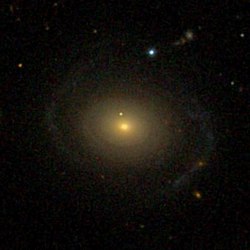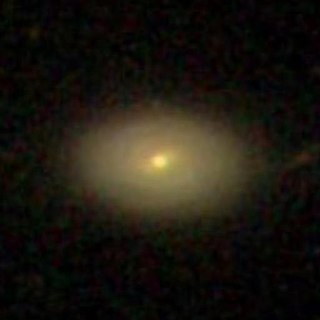
NGC 4060 is a lenticular galaxy located 320 million light-years away in the constellation Coma Berenices. It was discovered by astronomer Albert Marth on March 18, 1865 and is a member of the NGC 4065 Group which is part of the Coma Supercluster.

NGC 4055 is an elliptical galaxy located 310 million light-years away in the constellation Coma Berenices. It was discovered by astronomer William Herschel on April 27, 1785. It was rediscovered by John Herschel on April 29, 1832. It is listed both as NGC 4061 and NGC 4055. NGC 4055 is a member of the NGC 4065 Group and forms an interacting pair with its companion, NGC 4065 as evidenced by distortions in their optical isophotes.

NGC 4065 is an elliptical galaxy located 300 million light-years away in the constellation Coma Berenices. The galaxy was discovered by astronomer William Herschel on April 27, 1785. It was then rediscovered by John Herschel on April 29, 1832 and was listed as NGC 4057. NGC 4065 is the brightest member of the NGC 4065 Group.

NGC 4066 is an elliptical galaxy located 340 million light-years away in the constellation Coma Berenices. The galaxy was discovered by astronomer William Herschel on April 27, 1785. NGC 4066 is a member of the NGC 4065 Group.

NGC 4070 is an elliptical galaxy located 340 million light-years away in the constellation Coma Berenices. NGC 4070 was discovered by astronomer William Herschel on April 27, 1785. It was rediscovered by John Herschel on April 29, 1832 and was listed as NGC 4059. The galaxy is a member of the NGC 4065 Group.

NGC 4072 is a lenticular galaxy located 300 million light-years away in the constellation Coma Berenices. The galaxy was discovered by astronomer Ralph Copeland on April 3, 1872 and is a member of the NGC 4065 Group.
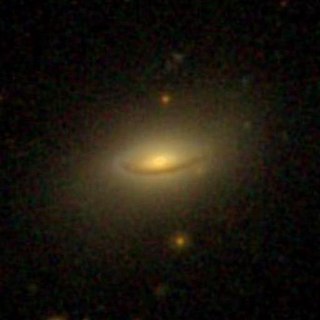
NGC 4074 is a peculiar lenticular galaxy located 310 million light-years away in the constellation Coma Berenices. It was discovered by astronomer William Herschel on April 27, 1785 and is a member of the NGC 4065 Group.

NGC 4076 is a spiral galaxy located 290 million light-years away in the constellation Coma Berenices. The galaxy was discovered by astronomer William Herschel on April 27, 1785 and is a member of the NGC 4065 Group.
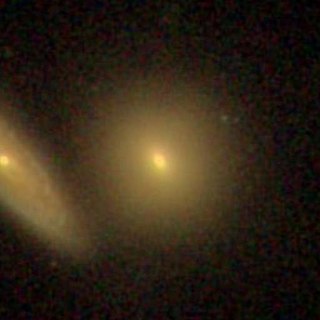
NGC 4089 is an elliptical galaxy located 340 million light-years away in the constellation Coma Berenices. NGC 4089 was discovered by astronomer Heinrich d'Arrest on May 4, 1864 and is a member of the NGC 4065 Group.

NGC 4090 is a spiral galaxy located 340 million light-years away in the constellation Coma Berenices. The galaxy was discovered by astronomer Heinrich d'Arrest on May 2, 1864 and is a member of the NGC 4065 Group.

NGC 4091 is a spiral galaxy located 360 million light-years away in the constellation Coma Berenices. The galaxy was discovered by astronomer Heinrich d'Arrest on May 2, 1864. NGC 4091 is a member of the NGC 4065 Group and is a LINER galaxy.

NGC 4092 is a spiral galaxy located 310 million light-years away in the constellation Coma Berenices. It was discovered by astronomer Heinrich d'Arrest on May 2, 1864. NGC 4092 is a member of the NGC 4065 Group and hosts an AGN.

NGC 4093 is an elliptical galaxy located 340 million light-years away in the constellation Coma Berenices. The galaxy was discovered by astronomer Heinrich d'Arrest on May 4, 1864. NGC 4093 is a member of the NGC 4065 Group and is a radio galaxy with a two sided jet.
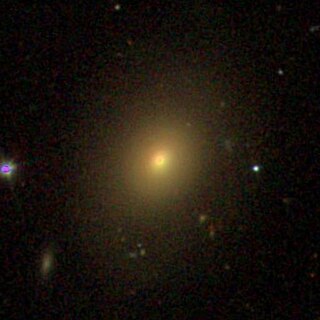
NGC 4095 is an elliptical galaxy located 330 million light-years away in the constellation Coma Berenices. The galaxy was discovered by astronomer William Herschel on April 26, 1785. NGC 4095 is a member of the NGC 4065 Group and is a LINER.

NGC 4098 is an interacting pair of spiral galaxies located 330 million light-years away in the constellation Coma Berenices. NGC 4098 was discovered by astronomer William Herschel on April 26, 1785. It was then rediscovered by Hershel on December 27, 1786 was listed as NGC 4099. NGC 4098 is a member of the NGC 4065 Group.

The NGC 4065 Group is a group of galaxies located about 330 Mly (100 Mpc) in the constellation Coma Berenices. The group's brightest member is NGC 4065 and located in the Coma Supercluster.

NGC 4294 is a barred spiral galaxy with flocculent spiral arms located about 55 million light-years away in the constellation Virgo. The galaxy was discovered by astronomer William Herschel on March 15, 1784 and is a member of the Virgo Cluster.
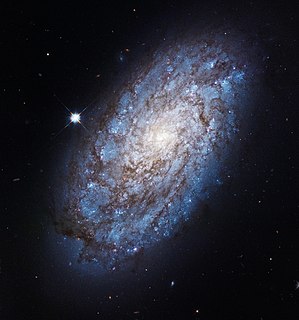
NGC 4298 is a flocculent spiral galaxy located about 53 million light-years away in the constellation Coma Berenices. The galaxy was discovered by astronomer William Herschel on April 8, 1784 and is a member of the Virgo Cluster.

NGC 4299 is a spiral galaxy located about 55 million light-years away in the constellation Virgo. It was discovered by astronomer William Herschel on March 15, 1784 and is a member of the Virgo Cluster.

NGC 4307 is an edge-on spiral galaxy located about 65 million light-years away in the constellation Virgo. It was discovered by astronomer Christian Peters in 1881 and is a member of the Virgo Cluster. It is also a LINER galaxy.
